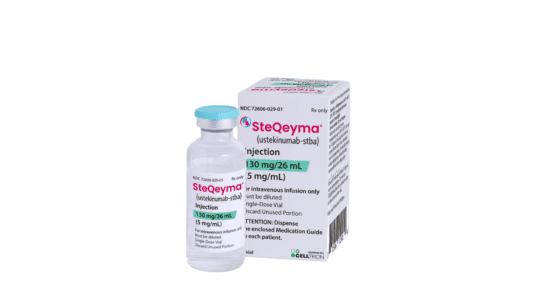Steqeyma Side Effects
Generic name: ustekinumab
Medically reviewed by Drugs.com. Last updated on Aug 10, 2025.
Note: This document provides detailed information about Steqeyma.
Applies to ustekinumab: parenteral injection, parenteral injection concentrate Side Effects associated with ustekinumab. Some dosage forms listed on this page may not apply specifically to the brand name Steqeyma.
Applies to ustekinumab: parenteral injection, parenteral injection concentrate.
Side effects include:
Patients with psoriasis (≥3%): Nasopharyngitis, upper respiratory tract infection, headache, fatigue.
Patients with psoriatic arthritis (≥3%): Adverse effects similar to those in patients with psoriasis.
Patients with Crohn disease (≥3%): Vomiting during induction therapy; nasopharyngitis, injection site erythema, vulvovaginal candidiasis/mycotic infection, bronchitis, pruritus, urinary tract infection, sinusitis during maintenance therapy.
Patients with ulcerative colitis (≥3%): Nasopharyngitis during induction therapy; nasopharyngitis, headache, abdominal pain, influenza, fever, diarrhea, sinusitis, fatigue, nausea during maintenance therapy.
For healthcare professionals
Applies to ustekinumab: intravenous solution, subcutaneous solution.
Respiratory adverse events
- Common (1% to 10%): Nasopharyngitis, upper respiratory tract infection, oropharyngeal pain
- Uncommon (0.1% to 1%): Nasal congestion[Ref]
Nervous system
- Common (1% to 10%): Headache, dizziness
- Uncommon (0.1% to 1%): Facial palsy[Ref]
Other
- Common (1% to 10%): Fatigue[Ref]
Gastrointestinal
- Common (1% to 10%): Diarrhea, nausea[Ref]
Musculoskeletal
Local
- Common (1% to 10%): Injection site erythema, pain, bruising, irritation
- Uncommon (0.1% to 1%): Injection site reactions (including hemorrhage, hematoma, induration, swelling, and pruritus)[Ref]
Dermatologic
- Common (1% to 10%): Pruritus
- Uncommon (0.1% to 1%): Pustular psoriasis, skin exfoliation
- Rare (less than 0.1%): Exfoliative dermatitis
- Postmarketing reports: Erythrodermic psoriasis[Ref]
Psychiatric
- Common (1% to 10%): Depression[Ref]
Oncologic
- Common (1% to 10%): Malignancies (1.7%)
- Postmarketing reports: Rapidly appearing, multiple cutaneous squamous cell carcinomas[Ref]
Hypersensitivity
- Uncommon (0.1% to 1%): Hypersensitivity reactions (including rash, urticaria)
- Rare (less than 0.1%): Serious hypersensitivity reactions (including anaphylaxis and angioedema)[Ref]
Immunologic
- Very common (10% or more): Infections (up to 27%)
- Common (1% to 10%): About 6% of patients developed antibodies to this drug, dental infections
- Uncommon (0.1% to 1%): Cellulitis, herpes zoster, viral upper respiratory tract infection[Ref]
See also:
References
1. Cerner Multum, Inc. "UK Summary of Product Characteristics."
2. Cerner Multum, Inc. "Australian Product Information."
3. (2009) "Product Information. Stelara (ustekinumab)." Centocor Inc
Frequently asked questions
- What biosimilars have been approved in the United States?
- Do I qualify for the Stelara copay card & how can I save?
- What is the mechanism of action of Stelara and how does it work?
- What are the new drugs for plaque psoriasis?
- How long can you keep Stelara in or out of the fridge?
- How quickly or how long before Stelara starts to work?
- Can you get a flu shot or take antibiotics while on Stelara?
- How is Stelara injected or administered?
More about Steqeyma (ustekinumab)
- Check interactions
- Compare alternatives
- Pricing & coupons
- Drug images
- Dosage information
- During pregnancy
- FDA approval history
- Drug class: interleukin inhibitors
- Breastfeeding
- En español
Patient resources
Other brands
Stelara, Yesintek, Wezlana, Selarsdi, ... +3 more
Professional resources
Other brands
Stelara, Yesintek, Wezlana, Selarsdi, ... +3 more
Related treatment guides
Further information
Steqeyma side effects can vary depending on the individual. Always consult your healthcare provider to ensure the information displayed on this page applies to your personal circumstances.
Note: Medication side effects may be underreported. If you are experiencing side effects that are not listed, submit a report to the FDA by following this guide.

